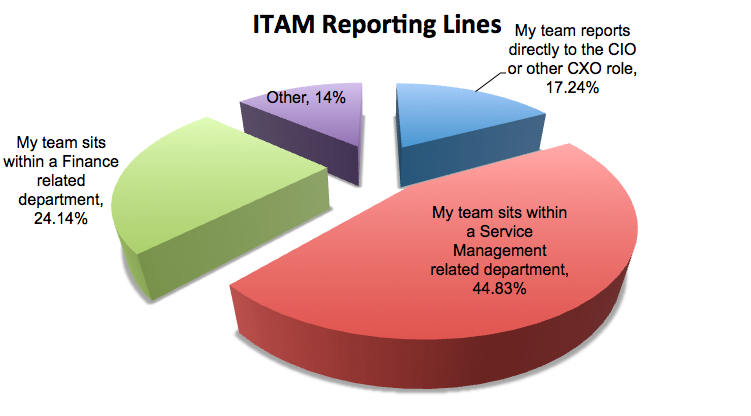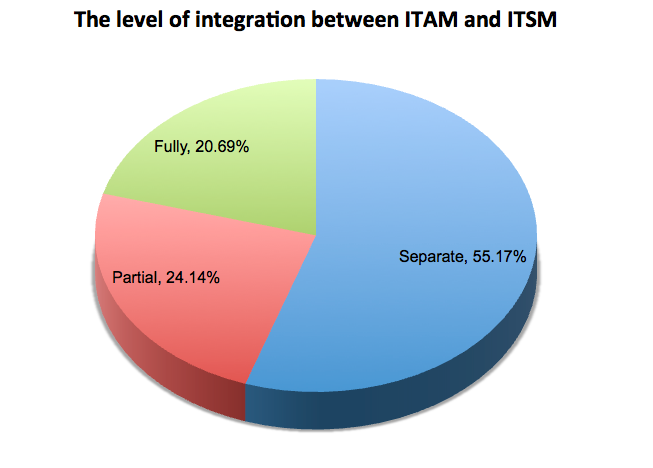How Well is ITAM Integrated into ITSM?
Back in August I conducted a survey into how ITAM is integrated into ITSM. Thank you to all those who took the time to participate.
I believe there is a great opportunity to bring ITAM and ITSM closer together for mutual benefit. This survey asked how ITAM was positioned within the respondents company and the level of integration between the two disciplines.
In a nutshell: There is a desire to integrate ITAM and ITSM. But for the majority, they are separate or only partially integrated entities.
Where Does ITAM Sit In The Business?
Firstly, respondents were asked their reporting lines. I was interested to see where ITAM sat as a business function in relation to ITSM. 45% said their ITAM function was a part of ITSM, 24% said it sat within a finance function and 17% reported directly to CIO/CXO. I can see the logic in placing ITAM in each one of these departments, but for long term value and efficiency I believe the best fit is either within ITSM or directly to the CIO. ITAM should be a proactive function – not just clearing up the mess and ensuring compliance but providing a dashboard of the costs and value of services so the business can change accordingly.

ITAM and ITSM Integration
Next respondents were asked the level of integration between their ITAM and ITSM functions. 55% said it was a completely separate entity, 24% said is was only partially integrated and 21% said that the two functions were fully integrated. As I have said before, ITAM can help ITSM quantify value and justify its existence, whilst ITSM can help ITAM be a proactive BAU process rather than being campaign led.

Anecdotally:
- “Very integrated. ITSM works within and is included as part of ITAM as a whole.”
- “Silo and decentralized”
- “Partially integrated. ITAM is seen as license counting where as ITSM covers all ITIL processes.”
- “ITAM and ITSM function as separate departments within our IT division of the organization. Mainly, ITSM delivers and supports hardware and software with end customers whereas ITAM manages contractual obligations and lifecycle tracking from acquisition to disposal. However, both collaboratively work on setting standards for IT equipment and software as well as addressing non-standard requests. ITAM owns the designation and policing of those standards.”
- “It has been difficult for folks here to understand both the relationships between ITIL and ITAM, and the differences. I continually rehash. The repository should be linked to the CMDB, because they share some information, but they serve two separate purposes.”
- “Getting tighter. We’ve started becoming a source of truth for contractual and inventory data into the CMDB”
- “Systems are unconnected. Teams report to different managers, but both report up to CIO.”
- “Today, there is no integration. We are involved in starting 2nd generation of ServiceManagement (ITIL V3). Along with this, we are starting to create a Asset Management function, which will integrate with ITSM.”
Finally, ITAM Review readers were asked what they need help with regarding ITSM (This is the rudder which guides future content):
- “Helping identify reasons to justify a closer integration between the two areas – the target audience is ITSM – persuading them to take ITAM seriously.”
- “ITSM Management Tools, Trends, News, Studies and Experiences”
- “Understanding the performance metrics for AM through ITSM processes”
- “Building a strong business case for integration between ITAM and ITSM”
- “Benchmark figures about maintaining ITSM products. I.e what does it cost to maintain Remedy vs Topdesk, vs HP ITSM etc.”
- “Clarify the licensing metrics of each vendors. Have a place where people can share there experiences.”
- “Understand how SAM can integrate with ITIL process but how much it should retain it’s own identity and visibility. Its important not to loose it in the ITIL stable as we have spent years fighting for it’s independence and importance. As for the Hardware assets, guidance on how to distiguish between Configuration Management and Asset Management and how they co-exist effectively and without confusion would be useful.”
- “The dynamic of ITSM delivering software to end customers, and ITAM working to track and control the licensing. In our organization it is a struggle to clearly communicate the intricacies of licensing to our ITSM technicians for the thousands of applications we support. It is much the same for trying to communicate the severity of non-compliance.”
- “The relationship between SAM and the ITIL framework. (In our organization, service management falls under the CIO org, but asset management falls under the CFO org.) I’d like to know how other companies have integrated the two.”
- “Integrating the service desk, asset management and procurement into a communicating entity”
- “How ITAM fits into the SACM space. A is for Asset which comes before Configuration. Which is true from a procurement perspective. However CI’s need to come before Change, Incident and Problem Management. Bottom Line, how to integrate ITAM into ITSM and win support of its needs for the business from a ITSM perspective.”
- “Help us determine right tool that best fits our environment. Is straight SaaS the way to go? SaaS solution hosted onsite? On-premise solution? Who are the key vendors?”
- “I agree with you. I think there is significant overlap between ITAM and ITSM which are not commonly realized. Your focus on this overlap would be helpful.”
ITAM Review Readers completed surveys during August 2011. 58 Responses (USA 59%, UK 14% Other 28%).
Can’t find what you’re looking for?
More from ITAM News & Analysis
-
Broadcom is removing expired VMware licences from its portal - take action now!
Hot on the heels of Broadcom’s announcement of the end of perpetual licences for VMware it has given customers barely a week to download any keys for licenses from its portal with expired support. This is ... -
Who Loses When Broadcom Wins?
News of a new Broadcom deal rarely arrives with great fanfare. The November 2023 VMware acquisition provoked open worry online and in business circles, with many critics wondering whether the former Hewlett-Packard spinoff’s reputation would prove ... -
Software Vendor Insights: What do the numbers tell us about the opportunities for ITAM negotiations?
What software vendor insights can be gained from the latest financial results from Amazon, Google, Broadcom, Salesforce, IBM and SAP? An important part of ITAM is paying close attention to the health of the companies we ...